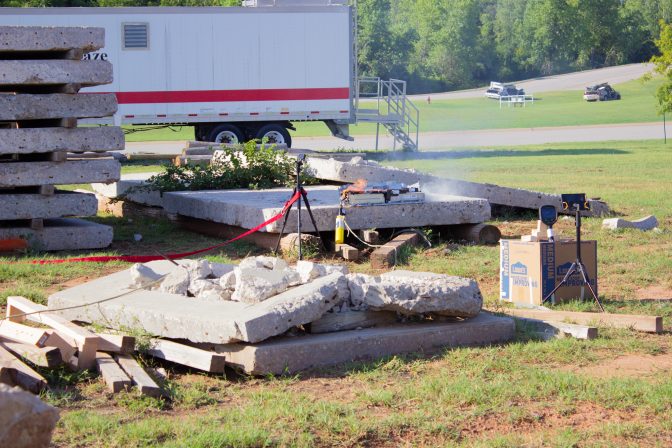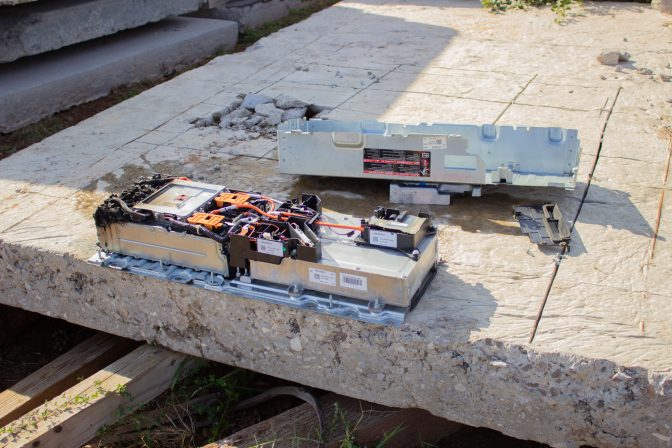September 26, 2022 | 4:14 pm
Faculty and administrators at the Francis Tuttle Technology Center gather around an electric vehicle (EV) battery that has caught fire in the Edmond Fire Department’s training area. On a warm August morning, thick smoke billowed from the sides, the cells burst intermittently, and the flames rose to about two feet high at their apex.
More electric cars on the road mean more questions about how emergency responders should adapt to the new technology at the scene of a crash.
The demonstration was designed to prepare Francis Tuttle for a new program launching this fall to train first responders on how to prepare for and manage alternative energy vehicle fires.The program consists of Forward OKCa collaboration of five central Oklahoma technology centers.
According to Edmond Fire Department Prevention Chief Jesse Benne, one of the main challenges facing electric vehicles is that there is little standardization among automakers — from battery location to battery location. chemical composition of lithium in.
“I think if we just know what we’re looking at, know what we’re dealing with and educate ourselves, I think we can mitigate it,” Benne said.

Beth Wallis/StateImpact Oklahoma
Flames poured from the side of an electric vehicle battery in the Edmond Fire Department training area.
With combustion engine vehicles, rescuers generally know what to expect in a crash on the job — most cars have the gas tank in the back and the motor in the front, Benne said. When rescuers saw a car hit from behind, he said they knew a fuel leak would occur. But electric cars are different.
“They can put the battery under the seat, they can put it under the car, across the floor,” Benne said. “They can put it in the trunk. They can put it in the front. They can literally put it anywhere they want. So far, there is no standard or manual for this car, That’s what you get.”
Although the National Fire Protection Association issued a Alternative Vehicle Fuel Guidelines For first responders in 2018, Benne said there should be an update.
Monte Doan, program developer and trainer for Francis Tuttle, said the field experiment was a fact-finding mission to understand how long it took for a battery to catch fire. Ultimately, it took about three minutes.
“one of them [electric vehicle batteries], the response is slow,” Dogan said. “As we can see, you start to get a little bit of smoke. Look, after a while, we got some little flames; it just gradually started to burn. Well, that answers a lot of our questions. “
In addition to knowing how much time rescuers have before an EV catches fire, the group learned the best ways to control a fire while teaching at the tech center, Doan said.he used a fire extinguishing system Made specifically for the electric car fire in the demo, he said three of them were strategically placed around the lab.
because Electric cars can be rekindled Fire suppression systems are designed to contain fires after hours or even days of seemingly extinguishing them so firefighters can flooded battery Plenty of water, lasts longer. Doan also has a fire blanket to put out the fire before firefighters arrive.
When an electric car battery catches fire burn hotter Compared to a gasoline-powered car fire — 4,900 degrees Fahrenheit compared to 1,500 degrees Fahrenheit — an electric car is significantly less likely to catch fire than a car with an internal combustion engine. research shows Electric cars have a 0.0012 percent chance of catching fire, compared to 0.1 percent chance of gasoline-powered cars.
While these percentages vary by institution conducting the study, the consensus is that gas-powered vehicles are about 50-80 times more likely to catch fire. But so far, hybrids with high-voltage batteries and internal combustion engines are more likely to catch fire than electric or gas vehicles. According to a research groupthe ignition probability of a hybrid vehicle is more than 138 times that of a pure electric vehicle.
The mere use of lithium batteries in a car accident can cause serious problems for first responders. Doan’s class will practice on the 2022 Ford Mustang Mach-E. While they don’t intend to set the car on fire, they hope to use the car to guide responders to the tricky location of the battery. In the Mustang, the battery is located under the hood, under the plastic panel, which he says is “unidentified.”
“The only way to open the hood is to get it out of the car,” Doan said. “When the vehicle is wrecked, if you can’t open the door (which you probably can’t), the only way to get inside the car is to break the window. Then, you’re in the manual door release. … the Mustang’s engine The cover releases, you have to pull it twice. And the… cable [could be broken] in a wreck. “
Doan said electrocution was another concern in dealing with electric vehicle wrecks.Although the study found Low risk of electric shock The high voltage levels (400 volts compared to the 12 volts in a gasoline-powered car battery) from a wrecked electric car are far more dangerous.
“All the high voltage wires are orange,” Doan said. “When first responders get in a car, they do one thing, they’re trained to use bolt cutters and cut 12-volt battery cables. Well, they get into one of those [EVs], they were in a hurry, they took bolt cutters and cut an orange wire. Now they are working on high pressure. “
captain. It’s important to remember that EVs aren’t necessarily more risky than gasoline-powered vehicles, but the technology is new and there’s a lot to learn, Benne said.
“I wouldn’t say that [EVs] More dangerous than an internal combustion engine with 35 gallons of gasoline underneath,” Benne said. “Anything can happen. This can be just as dangerous, or even more dangerous. “

Beth Wallis/StateImpact Oklahoma
An electric car engine sits on a concrete slab after it catches fire and cools.
First responder training courses begin at Francis Tuttle in November with approximately three classes per month, ranging from one day to one week. While the course is currently only open to first responders, training for municipal technicians is underway. To register, please email Walter.Miller@FrancisTuttle.edu.